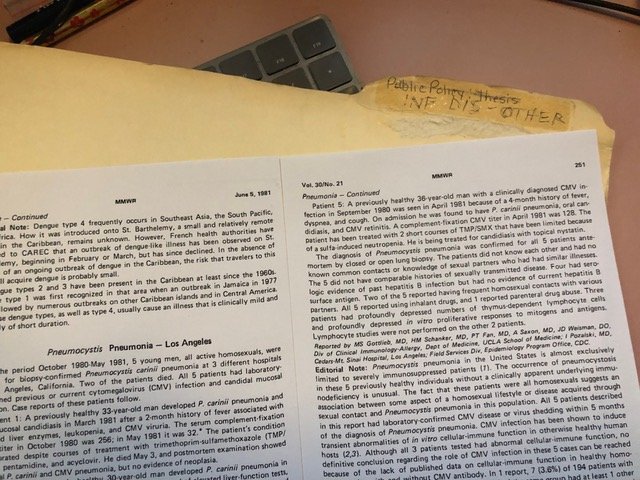Signs of AIDS Were There Before 1981
Let's talk about the first case of AIDS.
As I’m continuing to prepare things to send to the archive at the University of Rochester, I came across a couple of things that are relevant to the naming of what we know as HIV/AIDS.
Dr. Mike Gottlieb and Dr. Bill Valenti. Provided by Dr. Bill Valenti
I've talked about Dr. Mike Gottlieb, the UCLA immunologist who reported the first five cases of AIDS.
It started with his work seeing patients at UCLA. He got to talking with other people around LA and he put these five cases together and reported them to the Centers for Disease Control. That was the June 5, 1981 report.
That was our introduction to what became this explosive endemic of AIDS. Our lives were never the same.
A couple of years later, I was at a meeting and we were having dinner after the meeting. A long-time infectious diseases doctor from LA, Dr. Wilbert Jordan, said that that he had seen a case of AIDS in 1979.
We thought, what are you talking about? And he described this case.
Since Gottlieb's reports, they've gone back to the records and determined that this man also had AIDS. But that was in 1979 -- before any of us had heard about Gottlieb’s cases.
My point is that epidemics and pandemics don't just explode one day. They're always simmering someplace.
The case that our friend Wilbert Jordan knew about was one of several others that were popping up around not only LA but New York and other big cities. The cases weren't recognized as AIDS because we didn't know about it. So we just called it this obscure pneumonia that we now know is associated with AIDS, but never really recognized it for what it was.
If you really go back to the history of AIDS, in 1969 or so there was a teenage boy in St. Louis who was hospitalized with an unknown illness. Somebody had the foresight to save the autopsy materials. In the 1980s, people went back and looked at those materials from that young boy’s autopsy and found pieces of DNA from HIV in the autopsy material.
So the very first known case in the world is around the 1960s in the United States. It was probably just popping up, going around unnoticed -- one case at a time that came up with this undiagnosed or unknown illness. We never really knew what was going on until Mike Gottlieb reported those cases from Los Angeles in 1981.
So there are signals then. They sometimes go either unnoticed or overlooked until we go back and put the whole picture together. But sometimes you don’t see until you go back, and say, “Wait a minute.”
It’s the saying that hindsight is 20/20. It's understanding that when you see something unusual, pay attention. In any aspect of life, pay attention to what's around you.
There’s another dimension to the story about Gottlieb’s report.
The cover of the CDC’s Morbidity and Mortality Week Report for June 5, 1981. Provided by Dr. Bill Valenti
When you look at the internet for June 5, 1981 for that CDC report, the CDC has now reformatted it.
That report shows that Gottlieb's cases are on the front page of the June 5, 1981 report. But Gottlieb tells the story that there was something else on the cover and that his case is being reported on page two.
Page 2 of the June 5, 1981 edition of the Morbidity and Mortality Weekly Report, with Dr. Gottlieb’s report on AIDS cases. Provided by Dr. Bill Valenti
As for me, when I first read the Gottlieb cases back in 1981, I filed the report away in folder marked “Infectious Disease – Other” thinking, well, it's kind of interesting and I may need it in the future.
I had no idea what I was doing that day. But what I'm sending to the archive is the folder with “infectious diseases - other” labeled on the tab.



